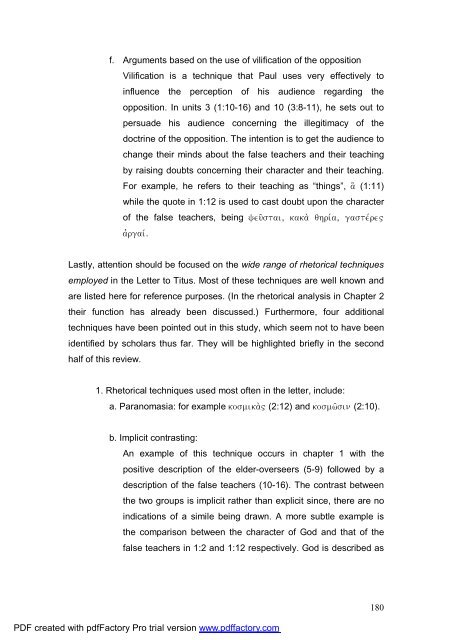A Text centred rhetorical analysis of Paul's Letter to Titus
A Text centred rhetorical analysis of Paul's Letter to Titus
A Text centred rhetorical analysis of Paul's Letter to Titus
You also want an ePaper? Increase the reach of your titles
YUMPU automatically turns print PDFs into web optimized ePapers that Google loves.
f. Arguments based on the use <strong>of</strong> vilification <strong>of</strong> the opposition<br />
Vilification is a technique that Paul uses very effectively <strong>to</strong><br />
influence the perception <strong>of</strong> his audience regarding the<br />
opposition. In units 3 (1:10-16) and 10 (3:8-11), he sets out <strong>to</strong><br />
persuade his audience concerning the illegitimacy <strong>of</strong> the<br />
doctrine <strong>of</strong> the opposition. The intention is <strong>to</strong> get the audience <strong>to</strong><br />
change their minds about the false teachers and their teaching<br />
by raising doubts concerning their character and their teaching.<br />
For example, he refers <strong>to</strong> their teaching as “things”, a} (1:11)<br />
while the quote in 1:12 is used <strong>to</strong> cast doubt upon the character<br />
<strong>of</strong> the false teachers, being yeu`stai, kaka; qhriva, gastevre"<br />
ajrgaiv.<br />
Lastly, attention should be focused on the wide range <strong>of</strong> <strong>rhe<strong>to</strong>rical</strong> techniques<br />
employed in the <strong>Letter</strong> <strong>to</strong> <strong>Titus</strong>. Most <strong>of</strong> these techniques are well known and<br />
are listed here for reference purposes. (In the <strong>rhe<strong>to</strong>rical</strong> <strong>analysis</strong> in Chapter 2<br />
their function has already been discussed.) Furthermore, four additional<br />
techniques have been pointed out in this study, which seem not <strong>to</strong> have been<br />
identified by scholars thus far. They will be highlighted briefly in the second<br />
half <strong>of</strong> this review.<br />
1. Rhe<strong>to</strong>rical techniques used most <strong>of</strong>ten in the letter, include:<br />
a. Paranomasia: for example kosmika;" (2:12) and kosmw`sin (2:10).<br />
b. Implicit contrasting:<br />
An example <strong>of</strong> this technique occurs in chapter 1 with the<br />
positive description <strong>of</strong> the elder-overseers (5-9) followed by a<br />
description <strong>of</strong> the false teachers (10-16). The contrast between<br />
the two groups is implicit rather than explicit since, there are no<br />
indications <strong>of</strong> a simile being drawn. A more subtle example is<br />
the comparison between the character <strong>of</strong> God and that <strong>of</strong> the<br />
false teachers in 1:2 and 1:12 respectively. God is described as<br />
PDF created with pdfFac<strong>to</strong>ry Pro trial version www.pdffac<strong>to</strong>ry.com<br />
180

















